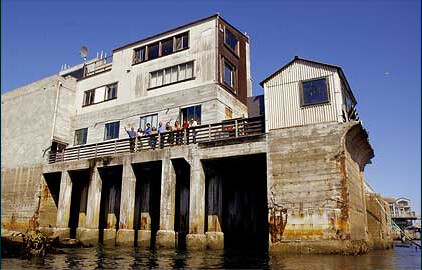It's five in the morning, just before sunrise and the dawn service of the Scripture Union Church School has begun with a morning song sung by the children of the boarding school. Their cherubic voices mark the beginning of a new day. It's a simple, soulful song, accompanied by a chorus of crickets and the calls of roosters that are waking near and far. I've been up since four thirty, and I don't think that I've started a day in such a beautiful way in a long time -- young voices under a still dark sky speaks clearly to me of the innocence of morning.
When we arrived at the bush meat market this morning at 5:45, it was clear that things were not going to go well for us. The doors of the small stalls were boarded and still locked and the people preparing the fires to smoke the meats looked at us suspiciously. As we stood by the roadside and awaited the arrival of the Queen Mother, sacks of dead animals were whisked by us, and ushered away so that we couldn't see them. When the Queen Mother arrived, our access to film was denied. There had been much talk between the vendors the previous night and it was decided that our intentions were not good. Recently the conservation group Conservation International had launched a campaign, "Say No to Bushmeat," which included a film. Those bush meat sellers included in the film were ostracized. Among the scientists whom we were set to film, there was a feeling that the CI campaign, while doing some good, had also produced some less than desirable results. Their point was that the the bush meat trade was becoming more underground, or at least less accessible to scientists wishing to study the trade. After approximately two hours of negotiations, we packed up our gear and moved on. Teddy, our fixer, Michael, the movie star, and Moses, one of our featured scientists, began immediately trying other avenues that might open some doors. They did their work as we moved on to the fish market.
As I write, Teddy and Michael are trying one last time to arrange a shoot at the bush meat market. If they're successful, we will be departing for our final scene of the day. If not, we will have develop another plan for covering the bush meat side of our story. Now, the crew is taking a well deserved break before heading out to capture city scenes. Everybody is exhausted after the shoot in the fish market. It was very hot and very crowded, and the air was thick with the smell of smoked and fresh fish -- and not all of the odors were pleasant.
Tomorrow we head North to our final destination, Mole National Park. (Pronounced Mole Ay.) Here we will be spending several days capturing material for the bulk of our sequence. Everybody is looking forward to getting out of the city and onto the savannahs of Ghana. This time of year, after the rains, Mole has been described to us as an Eden. We leave at 6:30 in the morning with high hopes of seeing elephants, antelope and of course, baboons! Internet access will be very sketchy if at all possible, so this might be my last entry for a little while. Our drive to Mole will take us approximately eight hours, and we all hope it is less stressful than the drive to Kumasi.
Friday, July 13, 2007
Africa Shoot: Kumasi July 13, 2007
Labels:
Africa,
David Elisco,
documentary,
filmmaking,
Ghana,
Strange Days on Planet Earth
Subscribe to:
Post Comments (Atom)

No comments:
Post a Comment